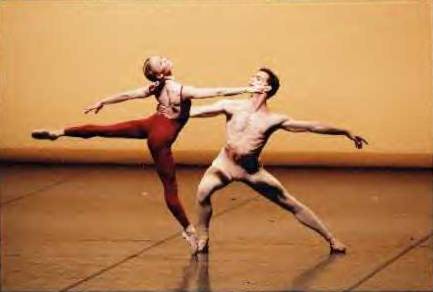|
<< -- 5 -- Sissy von Kotzebue PAS DE POSTHORN

Next, two surprisingly similar looking men dance with the woman in a very intense pas de trois. They 'dance her', meaning that she is being moved about by the two men rather than moving herself. She is caught between them, framed, fixed, tries to escape and, at last, the three stand close together, laying their heads on each others' shoulders, having found freedom.
Interesting here is the optical symmetry presented by the Bubenicek twins. The incredible image of two pretty men, looking just the same and having the same kind of motion, gives that pas de trois an additional dimension that underlines the dreamlike atmosphere of the scene.
This movement was dedicated to John Cranko who died, much too young at the age of forty five, on 26 June 1973. That Neumeier chose precisely this fourth movement to dedicate to his friend is significant. Here, Mahler uses elements of religious music, as choral phrases in the brass, alternated with meditative phases and archaic chords coming out of the deep. Mahler wanted to portray the tender human heart longing for God and reaching him finally -- what idea could better illustrate one's feelings for a friend who has passed away?
The fifth movement again quotes one of the Wunderhorn poems. 'Die himmlische Freud ist eine selige Stadt, die himmlische Freud, die kein Ende mehr hat' ('Heaven's joy is a blissful town, heaven's joy that has no end'). Two choruses and an alto soloist sing something like a mixture between nursery rhyme and common prayer, behind them a steady ding-dong of church bells. To imitate the musical speech of children, Mahler uses a pentatonic interspersed melodic.
Neumeier, who calls this part 'Angel', lets the childlike Silvia Azzoni dance her solo so lightly and gracefully that she seems to fly. Her poses are like a child's, playing hopscotch, feet bent at odd angles, arms reaching for something too high to get. 'For me, the purity of a child is speaking through this movement,' says Neumeier.
The theme of the sixth movement is a variation of the beginning of this symphony. At first, it sounded martial, now it has become reconciled, describing love and its countless forms. Unusual is the tempo Mahler chose: it's not, like in former symphonies, a fast final movement but a slow andante. Alternating between vivacious major and mourning minor, Mahler's musical utopia ends with long radiant sounds in D major. 'What love tells me is a summary of my feelings about all beings,' writes Mahler in 1896. Neumeier states: 'The heavenly principle of love in its completeness is not comprehensible. But one can sense it, in a man, for a while.'
The main character from the beginning (Jiri Bubenicek, who has been grand from first to last) here meets the angel-child from the previous movement. There is, again, the grey couple from the posthorn scene. With a grand ensemble dancing as the redeemed, the ballet ends on a positive note. In spite of lasting more than two hours without pause, sheer endless applause and standing ovations rushed over the happy choreographer and his wonderful company.

A scene from John Neumeier's Mahler 3 ballet. Photo © 2004 Holger Badekow
|
John Neumeier: 'With his music, Gustav Mahler leads us into regions we know of in the innermost sections of our hearts. Sometimes, he seduces us first with trivialities (a waltz, a country dance etc) that we like, but he uses those like bridges to reach a metaphysical dimension. This is why I am fascinated by Mahler.'
|

